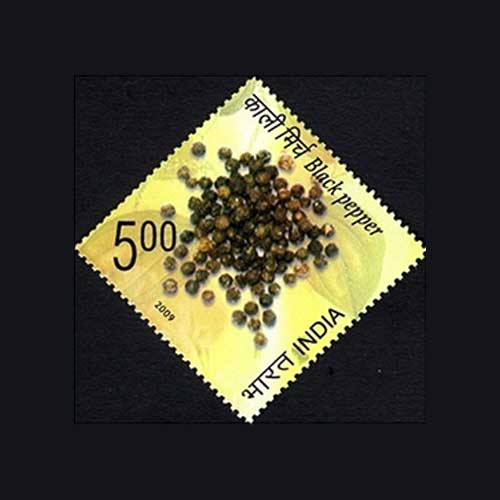Fascinating Archaeological Facts on Postage Stamps - 69
2025-07-09 Wed
Black pepper (Piper nigrum) is a perennial vine that is cultivated for its berries, which are extensively utilized as both a spice and in medicinal applications. India stands out as one of the leading Producers, consumers, and exporters of black pepper globally.According to the research paper titled "Origin and Evolution of the Genus Piper in Peninsular India" (2019), scholars assert that pepper species made their way to India following the Indo-Eurasian collision during the Eocene epoch (56 to 33.9 million years ago). Furthermore, the study indicates that black pepper originated in situ within the wet Evergreen forests of the Western Ghats during the Miocene epoch (23.03 to 5.3 million years ago).
Kerala is recognized as the birthplace of black pepper. Since the 3rd millennium BCE, Indian spices and other goods traded along the Indian Ocean have found Markets in the Mediterranean region, with black pepper emerging as one of the key Commodities in maritime trade. Notably, the earliest archaeological evidence of pepper consumption outside the Indian subcontinent dates back to ancient Egypt, where peppercorns were discovered in the nostrils of the mummified remains of Ramesses the Great, dating to 1213 BCE. Archaeological evidence also shows that 1600 peppercorns and teak wood were unearthed in Berenike in Egypt.
Crowned as ‘the king of spices’, black pepper is also among the ingredients of very important Ayurvedic medicine. According to Parthasarathi P. T in ‘Roman Control and Influence on the Spice Trade Scenario of Indian Ocean World: A Re?Assessment of Evidences (2015)’, Alexander introduced pepper’s Sanskrit name pippali, from which the Greek pipperi was derived and passed on to the #European languages through the Latin piper.
The early Roman Empire gained direct access to the Malabar Coast and its sought-after spices following its conquest of Egypt in 30BCE. Black pepper often referred to as "black GOLD," served as a form of currency during the Middle Ages. Notably, in 408 CE, Alaric, the King of the Visigoths, demanded 3,000 kilograms of pepper during the siege of Rome.
It was in pursuit of India—and consequently pepper—that Christopher Columbus stumbled upon America in 1492. Subsequently, in 1497, Vasco da Gama discovered the sea route to India around the Cape of Good #Hope. By 1511, the Portuguese had established Control over much of the spice trade from the Malabar region, importing two million kilograms of spices from India annually during the period from 1500 to 1600.
On 29 April 2009, India Post commemorated its spice heritage by issuing a set of five Stamps and a miniature sheet, featuring various Indian spices, including black pepper, with a denomination of Rs 5.
Latest News
-
Science and Technology on Indian Postage Stamps-6
2025-11-12 WedSir Mokshagundam Visvesvaraya is regarded as one of India's most distinguished engineers. His innova...
-
Science and Technology on Indian Postage Stamps-5
2025-11-11 TueSir Jagadish Chandra Bose recognized as India's first biophysicist was born on 30 November 1858, in ...
-
'Al-Sultan' Type Copper Double Falus of Malwa Sultan Ghiyath Shah
2025-11-07 FriAnother type of Copper Double Falus of Malwa Sultan Ghiyath Shah, weighing 17.5-18.1g. <br><br> I...
-
Science and Technology on Indian Postage Stamps-4
2025-11-07 FriThe last stamp in the series issued by India Post on 11 September 1997, to commemorate the 50th anni...
-
Science and Technology on Indian Postage Stamps-3
2025-11-06 ThuThe next #stamp in the series issued by #India #post on 11 #September 1997 commemorates the 50th an...

